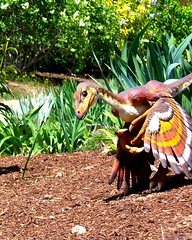
Sinosauropteryx is the first fossil dinosaur to have its color scientifically established.
Illustration courtesy James Robins
Published January 27, 2010
Pigments have been found in fossil dinosaurs for the first time, a new study says.
The finding may also open up a new world of prehistoric color, illuminating the role of color in dinosaur behavior and allowing the first accurately colored dinosaur re-creations, according to the study team, led by Fucheng Zhang of China's Institute for Vertebrate Paleontology.
The team identified fossilized melanosomes—pigment-bearing organelles—in the feathers and filament-like structures of fossil birds and dinosaurs from northeastern China.
Found in the feathers of living birds, the nano-size packets of pigment—a hundred melanosomes can fit across a human hair—were first reported in fossil bird feathers in 2008.
That year, Yale graduate student Jakob Vinther and colleagues, using a scanning electron microscope, discovered melanosomes in the dark bands of a hundred-million-year-old feather. In 2009 Vinther's group went on to show that another fossilized feather would have been iridescent in a living bird, due to microscopic light-refracting surfaces created by stacked melanosomes.
These earlier findings proved it was possible for melanosomes from dinosaur times to survive in fossils.
But until now no one had found the pigments in dinosaurs—other than birds, which many paleontologists consider to be dinosaurs. And no one had used melanosome shape and density to infer color.
End of Dinosaur-Bird Debate?
Even as the hundred-million-year-old bird melanosomes were being announced in 2008, the team behind the January 2010 report was using a scanning electron microscope to study minute details of feathered birds and dinosaurs found in Liaoning Province, China, a region famous for yielding thousands of exquisitely preserved animals that lived between 131 and 120 million years ago (prehistoric time line).
The Liaoning project put the team in a unique position to attempt the first melanosome discovery in dinosaurs.
"When we saw the Vinther paper, we said, Hey, look at this—and we found melanosomes immediately," said study co-author Mike Benton, a paleontologist at the University of Bristol in England.
The new study, published online today by the journal Nature, is "scientifically sound," said Hans Dieter-Sues, a paleontologist at the Smithsonian Institution 's National Museum of Natural History in Washington, D.C., who was not involved in the research.
"I think the researchers really are looking at the fossilized remnants of melanosomes," he added in his email.
Among the fossil dinosaurs studied were several that were preserved with dino fuzz, such as the turkey-size carnivore Sinosauropteryx.
The results reported today show that the filaments are packed with melanosomes in the same way as modern feathers.
"These filaments are probably the evolutionary precursors of true feathers," Benton said.
The Smithsonian's Sues added, "I think that one can safely say that this find invalidates some recent attempts to deny the existence of protofeathers in birdlike dinosaurs by claiming (without compelling evidence) that they are degraded collagen fibers."
Will this end the controversy about dino fuzz?
"It will definitely help end the debate," said Zhonghe Zhou, director of the Institute for Vertebrate Paleontology and a participant in the study.
"But there are still many issues that need to be further investigated," Zhou said. "What we've done here is to provide another line of evidence that the fiberlike filaments found in some dinosaurs are indeed protofeathers."
As for whether the discovery more securely establishes the evolutionary connection between dinosaurs and modern birds, the University of Maryland's Holtz said that, for him, previous, nonfeather discoveries had already settled the debate.
"I don't see that bonds already as strong as diamond links need any strengthening," said Holtz, who was not involved in the study.
A New World of Dinosaur Color
The discovery of melanosomes in fossil feathers also opens a window onto the previously unknown world of prehistoric color, because melanosomes contain the color-associated pigment melanin.
The two most common types of melanin found in modern birds are eumelanin, associated with black and grey feathers, and phaeomelanin, found in reddish brown to yellow feathers.
Melanosomes of both types were found during the new study, providing "the first empirical evidence for reconstructing the colors and color patterning" in dinosaurs and Chinese fossil birds, Zhang and his colleagues write.
For example, the 125-million-year-old early bird Confuciusornis was found to have color variation between blacks and browns in a single feather. And dark areas in Sinosauropteryx's tail were "absolutely packed with phaeomelanosomes," said Benton—a finding that led the team to propose that the dinosaur's tail was striped with "chestnut to rufous [reddish brown] tones."
The University of Maryland's Holtz said, "It seems reasonable to infer that the same size and shape melanosomes in dinosaurs would have resulted in the same colors as in modern birds."
But while melanosomes produce many feather colors, they can't make them all. Many bright feather colors, such as flamingo pink and canary yellow, are related to the foods birds eat.
And Sues, of the Smithsonian, said, "I would perhaps caution about direct inferences concerning coloration because the coloration on many present-day animals quickly changes after death as the color pigments degrade chemically."
Despite these limitations, the melanosome discoveries appear to mark the dawn of a new era for understanding the role of color in prehistoric worlds. Feather color in dinosaurs, for example, may reveal whether color patterns were useful for camouflage or peacock-like courtship displays, and if there were color differences between the sexes, as in many modern birds.
By searching for melanosomes and melanin not only in fossil feathers but also in other melanin-rich tissues, such as skin and hair, scientists, for the first time, won't have to guess at the colors of extinct creatures.
"All of the color reconstructions we made in the past were speculative," study co-author Zhou said. "Now we can add color to the ancient world and provide truly scientific reconstructions of extinct animals ."
The University of Maryland's Holtz is "looking forward to the first really well-supported painting" of the many dinosaurs, lizards, and mammals of Liaoning. Still, he said, "I feel a little bit sorry for the paleo-artists, who've had a relatively open book as to how they colored dinosaurs.
"Now we've moved this idea of dinosaur color out of the realm of art and into the realm of science."





















